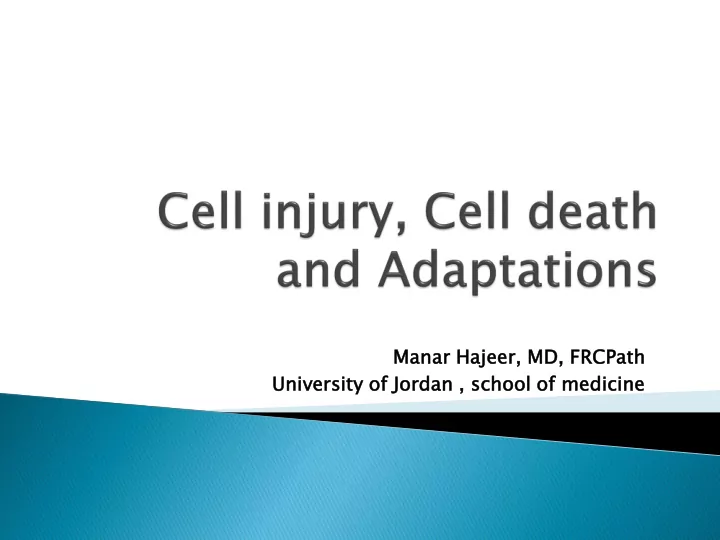

Manar Hajeer, , MD, FRCPath th Unive vers rsity ity of Jordan an , school ol of medicine cine
If the damaging stimulus is removed >>>injured cells can return to normal Morpho pholo logy: gy: Cellular swelling Fatty change
.
(1) plasma membrane alterations (blebbing, blunting) (2) mitochondrial change (swelling and densities); (3) dilation of ER (4) nuclear clumping of chromatin. (5) Cytoplasmic myelin figures
Irrversible Mitochondrial dysfunction 1. Loss of plasma membrane and intracellular membranes 2. >>> cellular enzymes leak out Loss of DNA and chromatin structural integrity . 3. Local inflammation. ▪
Increased cytoplasmic eosinophilia. Marked dilatation of ER , mitochondria. Mitochondrial densities. More myelin figures. Nuclear changes: Pyknosis : shrinkage and increased basophilia; Karyorrhexis :fragmentation; Karyolysis : basophilia fades
Different mechanisms, depending on nature and Apoptosis: optosis: severity of injury. Less severe injury. Regulated by genes and signaling pathways Controlled. Necro rosis sis: Rapid and uncontrollable. Severe disturbances Necro cropt ptosis osis. Ischemia, toxins, infections, and traum a
Leakage of intracellular proteins through the damaged cell membrane and ultimately into the circulation provides a means of detecting tissue-specific necrosis using blood or serum samples. Cardiac enzymes, liver enzymes.
Mo Morphologic phologic Patte tterns rns of of ti tissue sue ne necrosis osis
Conserved tissue architecture initially Anuclear eosinophilic on LM Wedge shaped following blood supply usually Leukocyte lysosomes and phagocytosis required for clearance Characteristic of all solid organ infarcts except the brain
Focal infections (pus) CNS infarcts Center liquefies and digested tissue is removed by phagocytosis
Clinical term It is coagulative necrosis Dry vs wet
“ Cheese like ” Combination of coagulative and liquefactive necrosis Tissue architecture is not preserved Acellular center Usually enclosed in an granulomatous inflammatory border Most often seen in TB
Occurs in acute pancreatitis Due to release of pancreatic lipases Focal fat destruction Released FA ’ s combine with Ca2+ (saponification) to produce the whitish chalky appearance
Visible by LM Deposits of antigen – antibody and fibrin complexes in arterial walls Seen in vasculitis
Recommend
More recommend